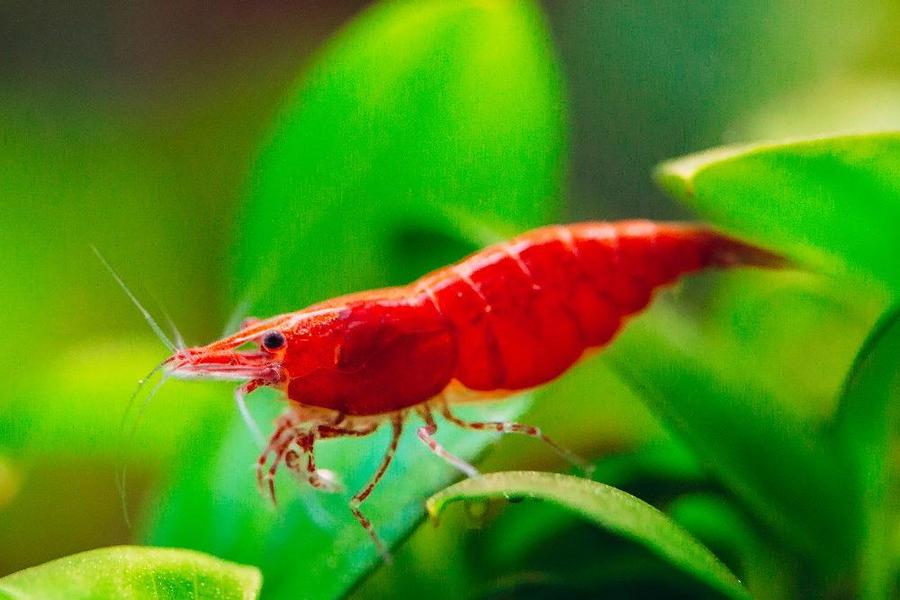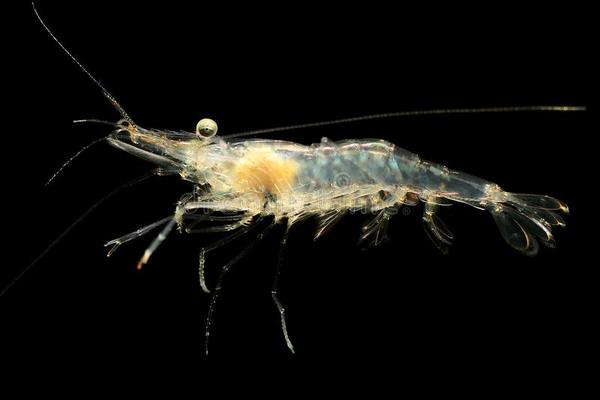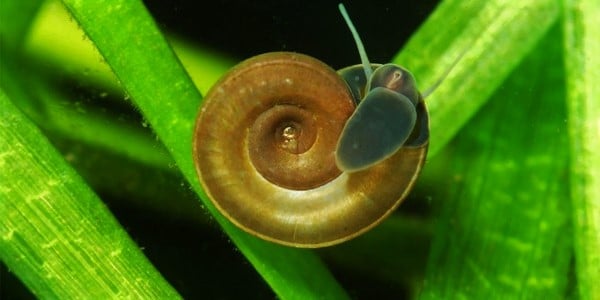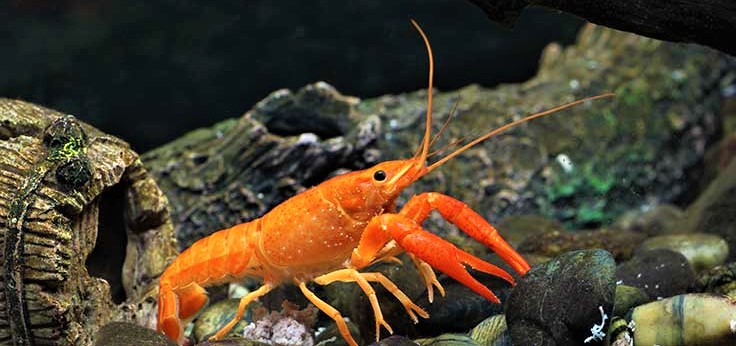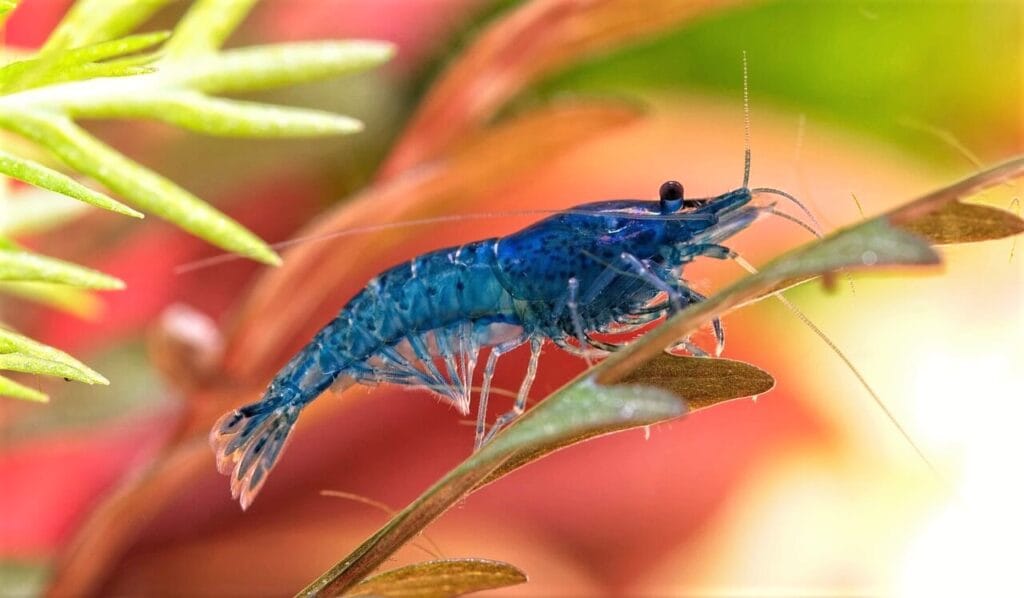Freshwater tank shrimps are the most overlooked creatures to add to your tank. We understand why everyone is attracted to fish, but there are different types of freshwater shrimp for aquarium. Shrimp give your tank a unique look, minimal maintenance, and help keep it cleans over time.
In short, you have a lot of benefits when you add something to your aquarium. They are spectacular creatures, and your aquarium will reap the rewards of having these algae grazing or filtering food creatures. These creatures make perfect additions to community tanks with small and quiet fish species. Freshwater shrimps are remarkable little creatures that come in every color except purple and are ideal for adding that little one to an extra pot. They are based on hardness, so while some are very difficult to keep, others require almost no worries.
This article will cover a wide variety of freshwater shrimp, testing equipment, and their common diseases. We will provide you with the basic knowledge needed to keep them within your home aquarium.
1) Blue Tiger Shrimp
- Care Level: Moderate
- Temperature Range: 65-75 °F or 18-24 °C
- Required pH: 6.0 – 7.5
The Blue Tigers are exotic freshwater shrimp and famous for their deep blue bodies and bright orange eyes. Blue tiger shrimp is a species of cantonensis caridina, so their maintenance requirements are straightforward. Holding blue tiger shrimps is not an easy species, but they are not very hardy.
As with any fish or invertebrate, a circulating tank and good water quality for freshwater shrimp are very important. If the water temperature is stable and the pH is within the acceptable range, and the nitrates are kept to a minimum, these stunning species should thrive in your aquarium.
Additionally, make sure to keep up with weekly / biweekly water changes. Like other cantonensis species, the blue tiger shrimp are omnivorous – meaning they eat both plant-based and meat-based foods. Since blue tigers are slightly more sensitive than different types of shrimp, make sure you do not overeat. Ammonia and nitrite spikes caused by overeating are hazardous to the shrimp tank.
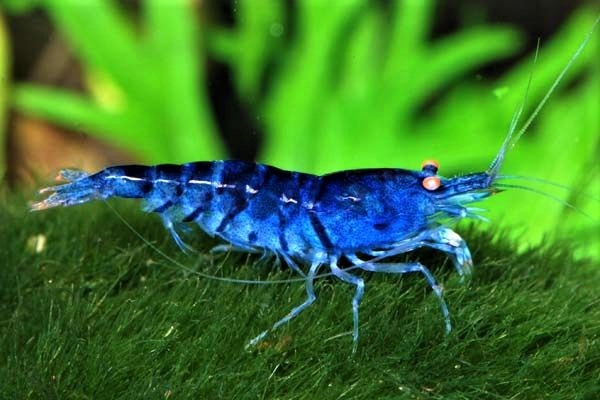
2) Red Cherry Shrimp
- Care Level: Easy
- Temperature Range: 77-81 °F or 18-29.5 °C
- Required pH: 6.3 – 8.0
Red cherry shrimp is one of the most popular types of freshwater shrimp for aquarium, characterized by its bright colors and texture. Compared to other shrimp species, red cherries are considered easier to maintain and can thrive in quieter social tanks unless there are aggressive tank mates. Different types of cherry shrimp are best to keep in a tank environment within the temperature mentioned above.
High temperatures promote rapid reproduction and growth but can be troublesome due to low dissolved oxygen concentrations. Low temperatures boost red cherry shrimp breeding and can use to reduce the expansion of large colonies. Feeding red cherry prawns is usually very easy.
A large settlement makes up an excellent cleaning team. As an omnivore, red cherry shrimp feed on algae and inedible/leftover fish. If you plan to keep the shrimp only in the tank, supplementation is always a good idea. Glasgarten Shrimp Dinner is a prawn dish that your red cherries should appreciate.
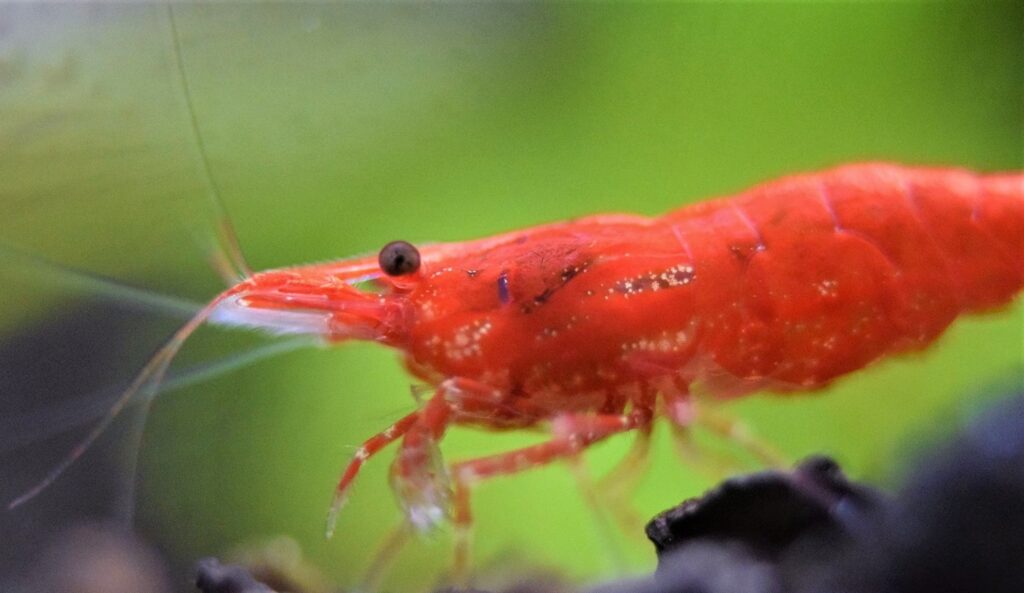
3) Blue Bolt Shrimp
- Care Level: Moderate
- Temperature Range: 65-75 °F or 18-24 °C
- Required pH: 6.0 – 7.5
If you look for unique and unusual shrimp for your fish tank, do not look any further. Blue bolts are one of the most beautiful types of blue freshwater shrimp creatures out there. Surprisingly, Blue Bolt shrimp is relatively rare and hard to find at a local fish store. If you plan to keep this race, it is a good idea to order online.
Blue bolt shrimp are another species of cantonensis, so their maintenance requirements are similar to blue tiger shrimps. They are particularly sensitive to ammonia, nitrites, and nitrates, so regular water changes are essential. They also prefer slightly acidic and soft water if you want to get a little more technical. Since the Cantonesis species are often bred, you should not have Blue Bolts with other shrimp species if you do not know what you are doing. Related shrimp species to know about: Blue Dream Shrimp
Fortunately, the Blue Bolt species alone do not need any assistance in the field of origin of the tank in general. Their unique color patterns offer ample variety, especially against the green of the planted tank.
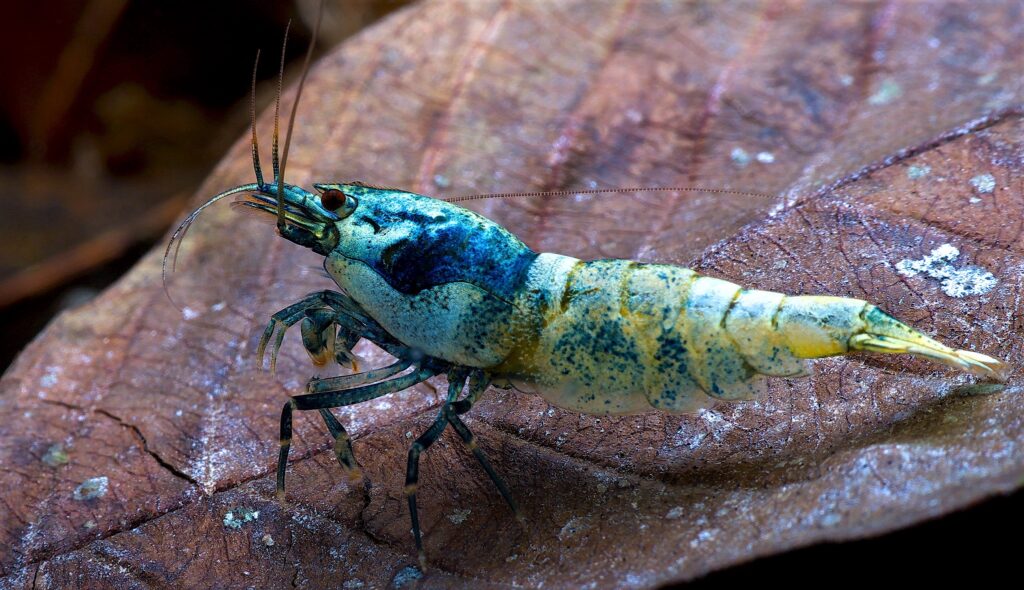
4) Crystal Red Shrimp
- Care Level: Moderate
- Temperature Range: 65-75 °F or 18-25 °C
- Required pH: 6.0 – 7.3
The Crystal Red Shrimp is one of the most selected types of freshwater shrimp species in the fish world. Over the past few years, the demand for this breed has exploded, and experts have developed the Crystal Reds into stunning and unique forms, many of which can fetch high prices. The price of crystal red shrimps is often based on where they fall in the standard, including – SSS, SS, S +, S, A, B, C.
Crystal red shrimp with SSS quality is considered highly desirable and can fetch over $20 each. In general, high-quality CRS is whiter and dense than low quality. Crystal Red Shrimp is an excellent choice for those who want to set up the shrimp tank and get involved in some breeding. CRS is a little more complicated than cherry shrimp, but their beauty and shape cause a slight increase in difficulty. Only the Crystal Red species will look so beautiful when the pots are done right.

5) Ghost Shrimp
- Care Level: Easy
- Temperature Range: 70-80 °F or 21-26 °C
- Required pH: 7.0 – 7.8
Ghost shrimp is without a doubt one of the coolest shrimp species on our list. They are much cheaper / more common and are generally considered fodder than pets. Ghost Shrimp, sometimes referred to as Glass Shrimp, is an excellent breed for first-time shrimp owners. If you only want to set up a good shrimp tank and have not had shrimp before, take some monsters to test your new setting.
Ghost shrimp are known as excellent gardeners, and they make a perfect addition to community fish stocks that are not aggressive fish. Those who do not eat will clear the base of the tank of inedible food, algae, and harmful. Ghost shrimp breeding is slightly different from other species. Unlike shrimp that hatch into miniature versions of adults, Ghost prawns hatch into shrimp larvae. It means they are more delicate than other organisms and are vulnerable at birth. The larvae should have no problem surviving in the shrimp-only tank.

6) Babaulti Shrimp
- Care Level: Easy
- Temperature Range: 65-85 °F or 18-29 °C
- Required pH: 6.5 – 7.8
Of all the species on our list, babaulti shrimp are probably the most underrated freshwater shrimp. They come in a variety of colors, including red, yellow, green, and brown. In addition, striped types are also very common. Despite their range of colors, babaulti is often obscured by common creatures such as crystal reds or cherry shrimp. Compared to other dwarf shrimp species, babaulti is much easier to maintain.
The basic requirements of any aquarium are complete cycle, no ammonia/nitrites, constant temperature / pH is still needed, but babaulti accepts minor mistakes. The omnipotent diet of Caridina babaulti is very similar to most dwarf shrimp species. This means a combination of plant-based and meat-based foods is usually the best option.
Babaulti shrimps have an exceptionally large appetite for rotting plant material, making them an excellent choice for planted pots. They do a great job of getting to the dead plants before decay occurs. It helps to reduce dissolved organisms and toxins such as ammonia, nitrite, and nitrate. Indian almond leaves are appreciated.
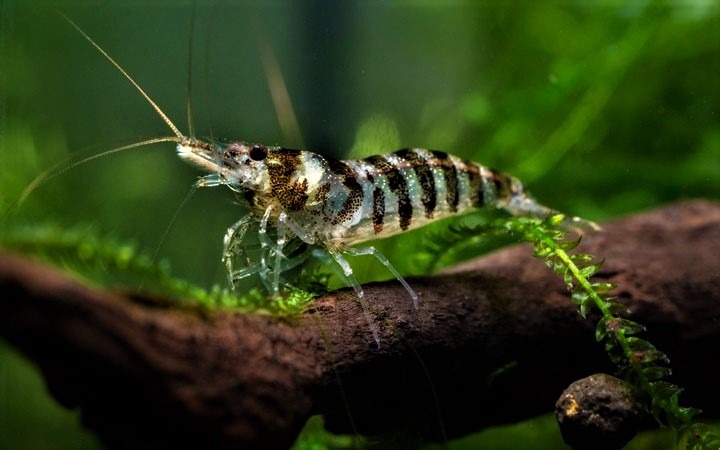
7) Sulawesi Shrimp
- Care Level: Hard
- Temperature Range: 77-87 °F or 25-30 °C
- Required pH: 7.5 – 8.5
If you are an experienced shrimp keeper, Sulawesi shrimp may be for you, and it is a challenging task. As their name suggests, these spectacular dwarf shrimp come naturally from the Sulawesi lakes of Indonesia. Sulawesi shrimp is by no means easy dwarf shrimp. They are so hard to keep alive.
Their beautiful colors make them very desirable types of freshwater shrimp for aquarium. If you want to give it a go, consider going to Cardinal Dennerly, also known as Cardinal Shrimp. Caridina dennerly is the most popular and common of the Sulawesi shrimp because it is easiest freshwater shrimp to keep. For these awesome red and white critters, you need to set up a single species of Sulawesi, i.e., high pH, warm water, and hard water with enough biofilm for you to cultivate. With a bit of luck, you may even find some offspring.
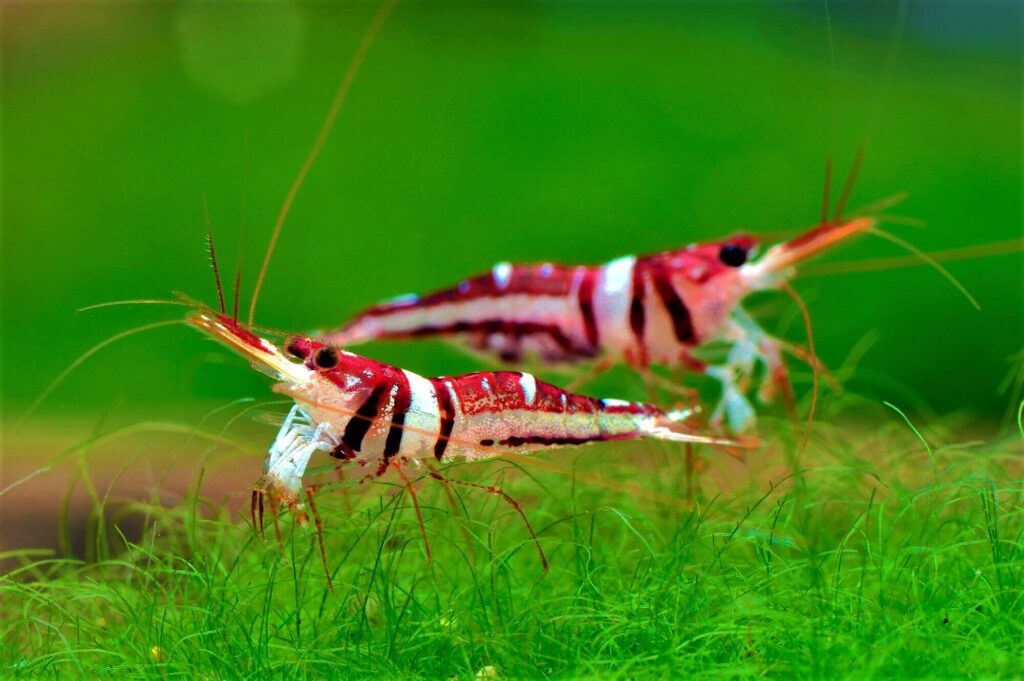
8) Amano Shrimp
- Care Level: Easy
- Temperature Range: 65-85 °F or 18-30 °C
- Required pH: 6.5 – 8.0
The perfect types of freshwater shrimp for aquarium list would not be complete without the famous Amano shrimp. Amanos are well-known for their greedy desire for algae. They are common among fish and need a little help to keep their tank clean.
This shrimp is not on the list of the best algae eaters. Not only are they excellent algae eater, but the Amano shrimp is also one of the most accessible creatures on our list to care for. As long as you keep your parameters stable, these shrimps can survive in a wide range of conditions.
This easy maintenance, along with their relatively large size 2-3″ maximum in length, makes amanos an excellent choice for community aquariums, make sure there are no predatory fish. While Amano shrimp are a great starting breed, they are not the best for making a big colony. Because the larvae need saltwater to survive, it isn’t easy to breed Amano shrimps.
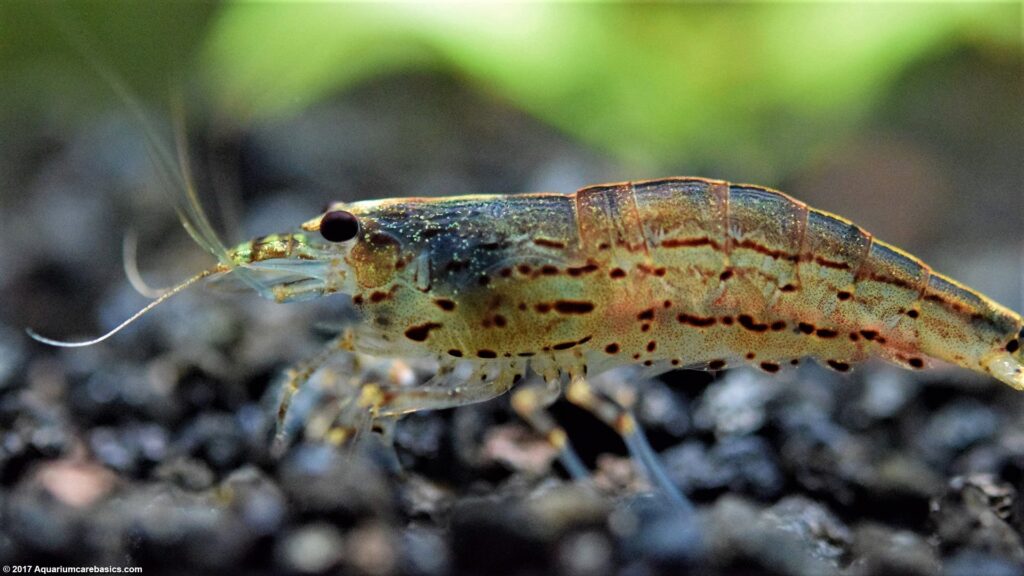
9) Snowball Shrimp
- Care Level: Easy
- Temperature Range: 63-82 °F or 20-30 °C
- Required pH: 6.3 – 8.2
Snowball is for beginner aqua culturists who want to set up their first shrimp tank or anyone looking for an easy-to-maintain shrimp. Snowball Shrimp tops the list. This type of neocaridina is easy to maintain, looks good, and does not require large/extensive settings.
Like their cherry shrimp cousins, Snowballs is not too hard to please when it comes to water conditions, making it an excellent choice for beginners. They can tolerate more fluctuations than other creatures.
However, you should try to keep your tank as stable as possible and thrive in a wide range of conditions. Not only is it easy to maintain, but snowball prawns are also very easy to breed and can multiply into a large colony at any time. Snowball shrimp are not the food of choice. They often escape detritus and algae. In a clean fish tank, occasional supplementation is essential.
As we have suggested with Red Cherry Shrimp, Glasgorten Shrimp Dinner is a great choice to keep your snowballs happy and healthy. Related Post to read: Snowball Pleco
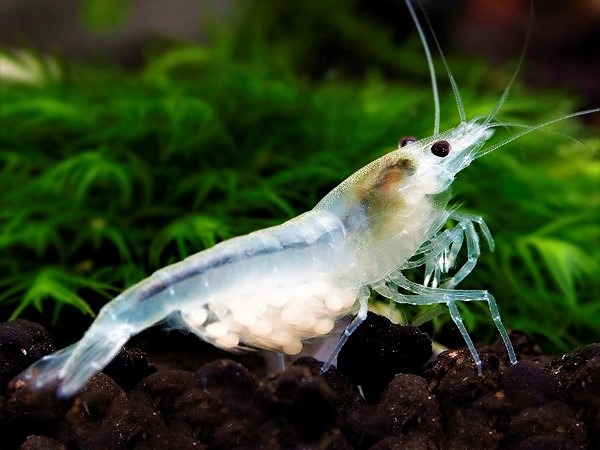
10) Panda Shrimp
- Care Level: Moderate
- Temperature Range: 64-76 °F or 16-25 °C
- Required pH: 6.1 – 7.5
Panda Shrimp, also known as Black King Kong Pandas, is a black and white variety of Cantonensis with an exciting background. At one point, Black King Kong was the most “exaggerated” dwarf shrimp in the hobby and could earn hundreds of dollars each. Panda shrimp usually fetch $10- $20 each in today’s market. That being said, they are still a great option for anglers looking for something a little more exclusive than the other creatures on our list.
Although black panda shrimp have a wide variety of cantonensis, they are more challenging to keep than their crystal red/black counterparts. They are particularly sensitive to changes in water levels, so it is recommended to keep this species in a large tank to avoid any parameter fluctuations.
In addition, pandas are wild freshwater shrimp and slower breeders than other species of cantonensis caridina. If you want to build a quick, manageable colony, pandas may not be the best choice.
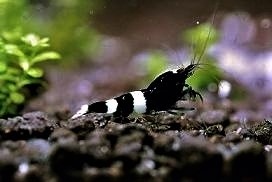
Test Equipment Needed for Shrimp Keeping
Shrimp species are more sensitive than fishes and require special testing equipment to keep normal ammonia, nitrite, nitrate, and pH level. If there is any ammonia or nitrite, your shrimp may say goodbye because they are incredibly vulnerable.
- Nitrates should not exceed 20 and should be kept at 10 or below.
- Shrimp also need tests for kH, gH, and TDS.
- Carbonate hardness, or kH, is often referred to as the buffer capacity of water and is closely related to pH.
- High kH means you can’t change your pH. And Low kH means you can easily alter the pH level.
- The general hardness, or GH, measures some of the minerals in the water, such as magnesium and calcium that shrimp need to make new shells.
- TDS measures the total dissolved solids and everything in water but does not tell you what it is. With low GH and TDS, shrimp cannot form new shells and die.
- If the GH and TDS are high, the shrimp will form a shell that will be too hard to melt, and it will die.
- Shrimp that dies from melting problems often have a white or clear band on the back of the head.
Common Diseases in Shrimps
Here are some common diseases to look after when keeping various types of freshwater shrimp for aquarium:
Bacterial Infection:
Bacterial infections in shrimp are often caused by poor water quality and can be very difficult to treat, depending on the severity. Affected shrimp often die with red or orange heads. Living shrimp may show the same symptom with a milky white or opaque interior. Anything from Kanaplex, tetracycline, and oxytetracycline can use in treatment. These are all antibacterial drugs that can treat gram-negative bacterial infections.
100% water change and reconsideration of shrimp to new water parameters will help substrate diversion or other excess debris and bad conditions caused by the structure. This helps to oxidize the water needed to cure the shrimp. If you use an antibacterial force, increase the ventilation as they remove some oxygen from the water.
Vorticella / Scutariellia japonica:
These parasites are microscopic and may appear at first glance as tiny obscure fungi. They are challenging to see clearly without a magnifying glass or similar, but they look like small, elongated triangles stuck in the sides of the shrimp, stomach, and rostrum. Taking a PraziPro dose will permanently get rid of them, and a saline nose is guaranteed.
The good news about these is that they are incredibly easy to cure and have a low mortality rate. However, you should remove the molten shells from the shrimp to prevent reheating, as they may be in the shells.
Rust Disease:
Red spot or rust disease is one of the most devastating shrimp diseases and can quickly kill hundreds of shrimp in weeks or months. It is characterized by red or black or red and black spots appearing on shrimp shells. The dots vary in size, shape, and color and may appear normal at first. This is usually caused by poor water quality or the lack of isolation of fresh shrimp.
Treatment ranges from hydrogen peroxide and oregano oil to levamisole HCL, which is used to treat callus worms up to a saline nose. Shrimp are surprisingly flexible when it comes to salt nozzles, so tips are not the wrong place to start.
Hydra:
Hydra is not a disease but something that commonly occurs in fisheries. This is only a problem if you fry or have small shrimp. Hydra has a small, dense body and seven slender tentacles. The body is usually only a few millimeters long, but the tents are two to three times longer.
Hydra connects the bottom of their body to a part of the tank with high flow to catch passing particles and infusoria. They especially like cobwebs, and if your cobwebs suddenly start to disappear, it may be an early warning sign that you have a hydra. Hydra is capable of moving themselves and entering through glass and substrate. They sting adult shrimp, which can kill them and kill and eat the shrimp. The best way to get rid of them is to measure the tank with fenbendazole, safe for shrimp but not for any snails.
Ellobiopsidae:
This is a relatively new issue with shrimp and, unfortunately, expands rapidly. Once you see what looks like green fungus on the bottom of your shrimp, your entire colony may be affected. It is a parasite, which so far seems to affect the only neocaridina. Separate any prawns that show green “fungus” in one pot, take all the “healthy” prawns in another pot, and let the old tank dry.
You need to start the tank and cycle it again. Some have been successful in using salt tips to get rid of the parasite, while others have been able to get rid of it using the diet provided with Gordon Reed Ich. Gordon Wright contains malachite green and formalin, and the combination of the two has the most significant success rate of treatment.
